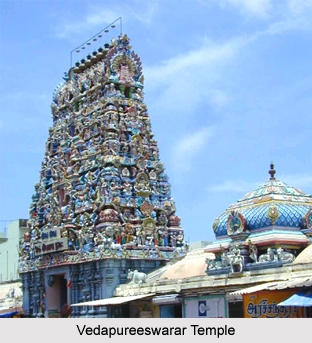 Vedapureeswarar Temple is situated in Puducherry and is largely thronged by people during festivities. The temple is situated 2 kms westward of the Pondicherry seashore and in between the Peria Brahmin Street, Siria Brahmin Street, Gandhi Street and Madhakoil Street. The temple had a glorious history 238 years back.
Vedapureeswarar Temple is situated in Puducherry and is largely thronged by people during festivities. The temple is situated 2 kms westward of the Pondicherry seashore and in between the Peria Brahmin Street, Siria Brahmin Street, Gandhi Street and Madhakoil Street. The temple had a glorious history 238 years back.
The temple was demolished and floored in the Vibava Year, Avani month (August-September), and English year 1748. With the painstaking efforts of Dewan Kandappa Mudaliar and public co-operation, the temple was reconstructed in the year 1788 (now in Gandhi Street). Vedapureeswarar Temple could not be reconstructed by Dupleigh Ranga Pillai as he wanted to do. Today, the temple appears in Gandhi Street with a majestic tower of 75 feet.
Rituals in the Vedapureeswarar Temple
Some of the popular festivities carried out in the temple are the 18 day Vaikasi (May-June) Brammotsavam, 10 days Navarathri in Purattasi (September-October), Annabishekam in Aipasi month (October-November), Sivarathri in Masi (February-March), Kruthika, Sankatahara Chaturthi, Adi Kruthikai, Thai Kruthikai, Chitra Poornima, Adipooram, Pradosha days are the festival days in the temple when the crowd will be huge. Also Deepavali, Pongal, Tamil and English New Year days, Pongal are also festive days in the temple.
Prayers at Vedapureeswarar Temple
Special Pujas are performed to Bhairava on Ashtami day (8th day from the new moon or full moon day). He ensures business development, family prosperity, freedom from enemies. People throng here for these benefits. Special Pujas are performed to each of the 63 Saivite Nayanmars on their respective star days and taken in procession. This is an important procedure followed in this temple.
Lord Muruga in this temple is praised by Sri Ramalinga Swamigal in his hymns. There is a special temple for Lord Dakshinamurthy within this temple on the southern side. The temple belongs to 18th century.
Prayers for marriage, children and for fulfilment of any aspiration placed at the feet of Lord Vedapureeswarar are rewarded without fail. The Lord grants mental peace to his devotees.
Devotees offer clothes to the lord, rosewater, tender coconut, curd, oil, sandal paste, cosmetic powder, sacred ashes etc. Devotees offer Sari to the Goddess. Devotees also fix fluorescent lamps in the temple. Distribute Prasad to the visitors, and also feed devotees.
The presiding deity is a Swayambu Linga. Lord Muruga in this temple is praised by Sri Ramalinga Swamigal in his hymns. It is said that the presiding deity was shifted to this temple from the Mission Street Samba Easwaran Temple 100 years ago. There is a special temple for Lord Dakshinamurthy within this temple on the southern side. The temple belongs to 18th century.





















